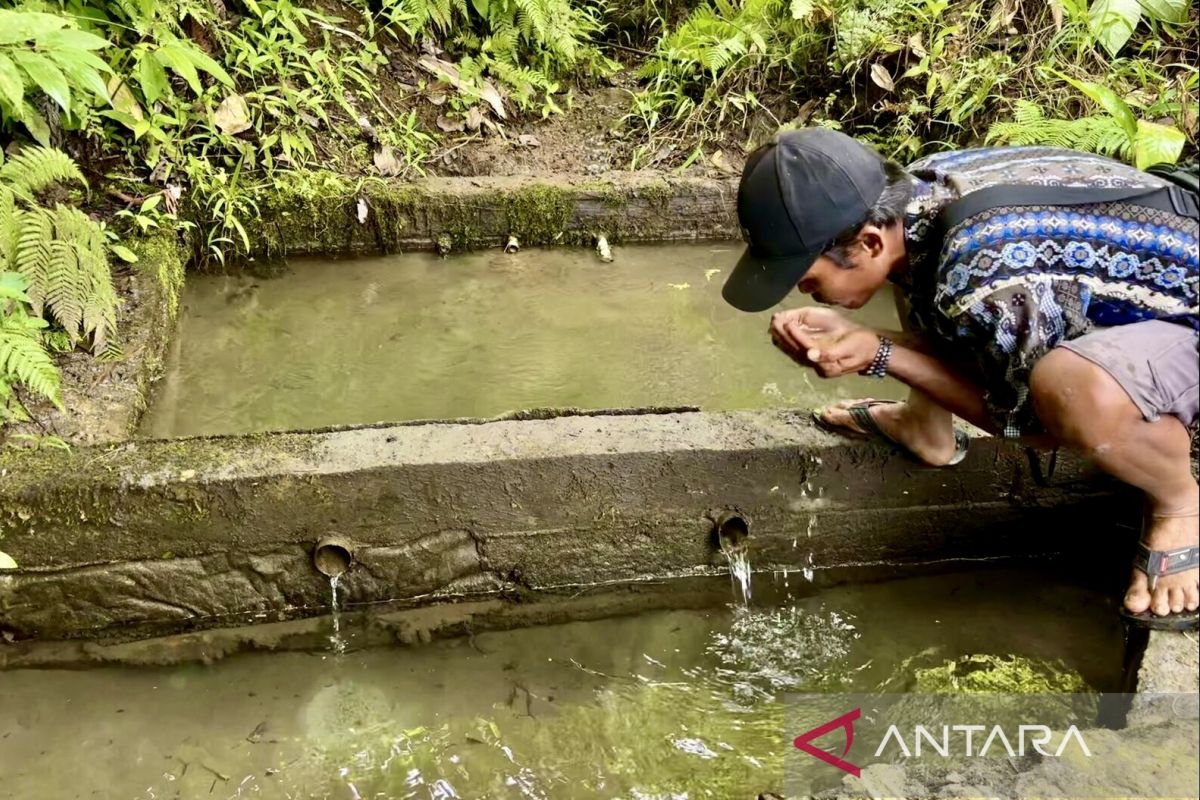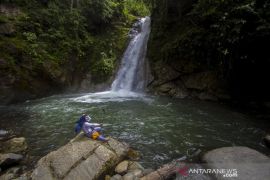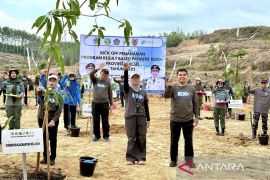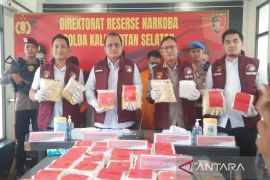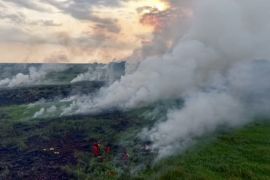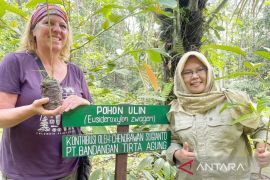The village, known as Hinas Kanan, is home to around 20 families of the Dayak Meratus ethnic group. Living among the residents of the village is a middle-aged man named Madi, who discovered a spring on Mount Hapuk, located five kilometers from the residential area.
Hinas Village itself sits dozens of kilometers away from Barabai, the capital of Hulu Sungai Tengah District.
As the sun starts returning to the horizon, its reddish-orange light reveals trees soaring on the Meratus Mountains, creating a mesmerizing natural scenery.
Madi, the father of two children and grandfather of one grandchild, lives atop a hill. In the past, he and the residents of the then-less-populated village had to embark on over 10 kilometers of walking to reach the foothills in order to acquire some water. Despite their high altitude, accessing water was a challenge.
However, the rabbit-hunting habit of the Dayak Meratus people at one point led to the discovery of a spring that has been utilized by Madi and other villagers ever since. Madi located the spring back in 2014 on a hill called Mount Hapuk.
It took Madi around two hours of walking to reach Mount Hapuk back then, when a proper path was non-existent. He used a machete to open up a path as he traversed the difficult terrain. He skillfully cleared bushes owing to the hunting prowess that has been passed down through generations.
The spring he found lies several meters away from a ridge that has a slope of 50–70 degrees. The discovery of the spring encouraged the villagers to exert their utmost efforts to preserve their environment, as they noticed that the water coming from the spring finds its origin in surrounding forests.
It is for this reason that the villagers are against mining activities and imposing strict rules on those looking to enter their village and its surrounding areas.
Moreover, the Hulu Sungai Tengah District Government has devised a long-term development plan that prioritizes the green revolution and forbids mining activities in the district.
"Note that the local government has been implementing a program that prompts its officials to routinely plant trees in an effort to ensure the sustainability of the Meratus Mountains," Head of Sungai Hulu Tengah District, Aulia Oktafiandi, stated.
Ever since the spring was discovered on Mount Hapuk, the Dayak Meratus people began their lives as farmers by planting cassava, bananas, vegetables, and tubers on vacant lands found in the mountainous region.
Their farming activities are not solely meant to pursue economic purposes but also serve as a means to preserve the beauty and sustainability of Mount Hapuk.
A traditional dam
Madi and fellow villagers built a dam near Mount Hapuk. They dug a hole in the spot where the spring was found using materials found in their surroundings.
The villagers worked hand in hand to gather rocks and stones and dug up the sand, mixing them up with a bit of cement, to construct a simple dam expected to reserve water.
In 2015, the Hulu Sungai Tengah Government provided the Dayak Meratus people with aid in the form of pipes instrumental for channeling water from the spring to their residential area. The local government also built a toilet, a bathroom, and a reservoir capable of storing 1,500 liters of water.
The discovery of the spring, coupled with the existence of the dam and all the assistance provided, have made the villagers’ lives more convenient. Today, they no longer need to descend to the foothills only to take a bath and get some clean water. A source of water can now be found 10–30 meters away from their houses.
Once every month, Madi hiked on Mount Hapuk to ensure that the water-channeling pipes were not clogged by leaves or twigs. He and the villagers usually allocate some portions of the profit gained from farming to maintain or replace pipes found to be worn out.
In June 2023, an El Nino-induced prolonged dry season hit Indonesia, leading to a decline in the volume of water in various regions, with districts and cities in South Kalimantan being no exception.
Head of the Meratus Mountains Post, Kasman Susanto, expressed hope that the local government would build essential infrastructure, such as roads and electricity, in Madi’s village. In response, the government decided to construct a nine-kilometer-long road connecting the village with the foothills, further facilitating the lives of the villagers.
Central government’s dam project
Hulu Sungai Tengah District Head Aulia Oktafiandi flew to Jakarta in last October to visit the Ministry of Public Works and Public Housing (PUPR), proposing the development of Pancur Hanau Dam, whose designated area is located eight kilometers away from Madi’s village.
"I have had an audience with the PUPR Ministry's Directorate General of Water Resources. The construction of this dam is essential, as it is related to the need for water for a large population," Oktafiandi remarked.
He also underlined that the dam is critically needed by Hulu Sungai Tengah District, which has been serving as the main food supplier for three districts in South Kalimantan and is envisioned as the "food gate" of Indonesia's new capital city, Nusantara.
The actualization of the dam project will free Madi and his fellow villagers from dependence on Mount Hapuk's spring, which is naturally susceptible to drought during a dry season.
Apart from providing the Dayak Meratus people with a sufficient water supply, the Pancur Hanau Dam will also serve as a reliable source of water required for irrigating rice fields.
The existence of the dam will potentially enable Hulu Sungai Tengah to irrigate an additional 5,500 hectares of land, raising the district's annual harvest volume from 60,000 tons to 120,000–130,000 tons.
The PUPR Ministry's Director of Dams and Lakes, Adenan Rasyid, noted that the proposal for the Pancur Hanau Dam's development had been incorporated into the ministry's program.
"We are currently conducting a feasibility study before building the Pancur Hanau Dam in Hulu Sungai Tengah. The development of the dam is meant to fulfill the people's needs," he stated.
Madi and the villagers are now living a more convenient life owing to the various infrastructures that have been built. Those living around Mount Hapuk have vowed to continue protecting and preserving nature and its wealth for the well-being of themselves and their descendants.
Related news: Exploring the unconventional destination of Meratus Mountains
Related news: A closer look at Dayak Meratus' thanksgiving ritual
Translator: Tumpal A, Tegar Nurfitra
Editor: Anton Santoso
Copyright © ANTARA 2024
